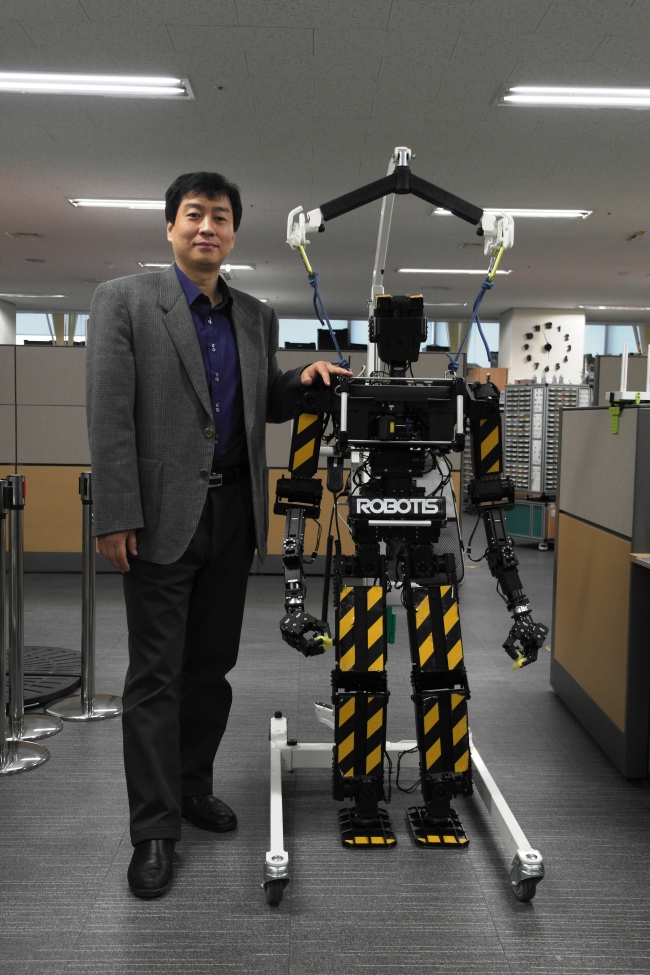The chief executive of Korean robot company Robotis hopes his firm will develop the nation’s first humanoid robot capable of disaster relief operations.
And THOR-MANG, the Tactical Hazardous Operations Robot, is his biggest hope.
The humanoid robot took part in the U.S Defense Advanced Research Projects Agency’s Robotics Challenge in December 2013 as part of a collaboration between Robotis and Virginia Tech, the University of Pennsylvania and Harris Corporation, coming ninth in the semifinals.
The competition was created in the wake of the Fukushima Dai-ichi nuclear disaster to promote the development of robots capable of conducting complex tasks in dangerous environments.
And THOR-MANG, the Tactical Hazardous Operations Robot, is his biggest hope.
The humanoid robot took part in the U.S Defense Advanced Research Projects Agency’s Robotics Challenge in December 2013 as part of a collaboration between Robotis and Virginia Tech, the University of Pennsylvania and Harris Corporation, coming ninth in the semifinals.
The competition was created in the wake of the Fukushima Dai-ichi nuclear disaster to promote the development of robots capable of conducting complex tasks in dangerous environments.

“We will make THOR-MANG more powerful and faster in order to compete in the final stage of the competition this December,” said Kim Byoung-soo, CEO of Robotis, in an interview with The Korea Herald.
However, two months before the Robotics challenge in 2013, THOR-MANG was urgently deployed after its predecessor, THOR ― created by Virginia Tech ― was unable to compete due to technical issues.
But at the time, THOR-MANG was unable to demonstrate its full capability.
“As the robot was smaller and lighter than others, it could not exert much power,” he said. For instance, it had difficulty in picking up a drill to make a hole in the wall, locking a heavy valve or climbing up a ladder.
However, THOR-MANG was good at driving. It received an award for the task as the University of Pennsylvania excels in developing driving algorithms, Kim said.
Kim was upbeat about the prospects for robots for disaster relief operations both at home and abroad.
“In the wake of the Fukushima Dai-ichi nuclear disaster, there has been global consensus to promote robotic technology for disaster-response operations.”
Domestically, the industry has lost its place as a priority, as it does not directly create jobs or boost the economy.
However, THOR-MANG’s success raised some interest after it competed in the international robotics challenge.
“The Ministry of Trade, Industry and Energy is planning to invest in the industry.”
More robots will have a place in human life in the future, he said.
Robots may not be familiar to ordinary people, but they are used in many areas. Rehabilitation, mine removal, factory automation, national defense and driverless vehicles are examples of this.
“Robotization will be one of the important factors in determining products’ competitiveness in the future,” he said.
By Shin Ji-hye (shinjh@heraldcorp.com)







![[KH Explains] How should Korea adjust its trade defenses against Chinese EVs?](http://res.heraldm.com/phpwas/restmb_idxmake.php?idx=644&simg=/content/image/2024/04/15/20240415050562_0.jpg&u=20240415144419)











![[Today’s K-pop] Stray Kids to return soon: report](http://res.heraldm.com/phpwas/restmb_idxmake.php?idx=642&simg=/content/image/2024/04/16/20240416050713_0.jpg&u=)